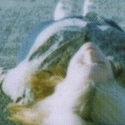|
Are there any English-language books or papers one would recommend on the judiciary (and hopefully also contemporaneous unofficial dispute resolution systems) in Early and/or Middle Imperial China? I've picked up Chinese Policing: History and Reform by Kam C. Wong that touches on pre-Qing "policing" and have found a few grad student papers discussing Qin legal manuscripts, but I'm not sure how to search further since my layperson approach of mining relevant Wikipedia articles for citations has come up short. Apologies if this is outside the purview of the thread.
|
|
|
|

|
| # ? May 10, 2024 00:53 |
|
I don't know why this was in my head today but I was working out and I suddenly thought of the Romans and wondered: What did they do for fitness for their soldiers? Did they even pay attention to it or have awareness that soldiers should be fit? Or was that just something that occurred naturally vis a vis the many miles that a soldier would have to march to go to war? I guess what I'm asking is: was Roman boot camp a thing?
|
|
|
|
My understanding was that it was an on-the-job thing with the veteran soldiers in a maniple being responsible for whipping the newbies into shape.
|
|
|
|
yes, they even had a special field for it, the field of mars. unsuprisingly to do the incredible feats of endurance, strength and engineering that the legionaries were famous for they needed an absolute ton of training, although i suspect most of it was on the job since you get people talking about how this legion is green or new or whatever in the histories.
|
|
|
|
They trained a lot, per Josephus and probably other contemporary writers, although I don't know what the training specifically consisted of. Their foremost drill field was the Campus Martius (Field of Mars), dedicated to the war god. Whether they had explicit exercise regimens or just "March a lot, build roads and forts, carry gear, practice fighting with wooden weapons" is not something I have any knowledge of. I know Greek athletes are recorded as having specific training techniques including lifting stones and animal bladders filled with sand that are almost identical to modern medicine-ball weights, but I don't know about Roman soldiers specifically. They absolutely understood gaining strength through exercise but I don't know if a centurion would routinely say "Drop and give me XX push-ups."
|
|
|
|
Nessus posted:Even if you couldn't make chain gears for bicycles, could you not build penny-farthings? That seems like you could get some stew cookin' Penny farthings put the rider very high off the ground, making them quite the balancing act to use. I don't think I'd want to ride one across rough terrain in a warzone. Tulip posted:I mean I guess but you could also just make a rickshaw or other 2 wheel cart. The lack of good cheap steel is a pretty big drag on efficiency. Or a Chinese wheelbarrow.
|
|
|
|
I don't know the details, but I think the transition from just expecting drafted citizen-soldiers to pick it up as they go along, and having a professional army that had well-drilled soldiers who signed up for a long career is reasonably well-documented I vaguely recall an anecdote from the transitionary period of a consul having his soldiers do gladiator drills mostly to occupy their time and keep them out of mischief before they had to march, and being surprised how much more effective the raw recruits were compared to usual Going back a few hundred years, the Greeks generally didn't drill phalanx maneuvers, except for Sparta which was envied for its ability to have its phalanx turn while still in formation. I think there's a passage from some source or other saying even the Spartans didn't both drilling the actual shock combat part of warfare because the idea of a phalanx (keep your shield up, try to push the enemy back, stab with your lance if there's an opportunity) is so basic that it just wasn't important I think you could reasonably expect nearly every able-bodied male citizen to be reasonably physically fit because farming is extremely tough physical labor (and anyone who didn't own a farm probably didn't qualify to be drafted). The Greeks also had public gymnasiums and a culture of athletic contests as routine entertainment. Not sure about the Roman equivalents, but the Greeks at least seemed to consider staying fit to be socially important, even for the upper class who could delegate the physical labor of their farms to slaves. The story is a bit different for naval recruits, because ancient naval warfare was extremely non-trivial and a brand-new rower was basically useless without extensive drilling. There's many stories of admirals taking the time to train their men instead of just rushing straight into battle, and societies such as Athens where nearly every male citizen had naval experience had a big leg up because they could start completing their objectives right away after declaring war instead of taking the time to train up the newbies. The story is also a bit different for ranged infantry (archers, slingers) and cavalry. Those tended to require skills which were difficult to train unless the soldier started as a child. Thus, you'd get regional specialties. For example, Crete was well known for having excellent archers, presumably because it was part of their culture to routinely train with a bow from a young age. This pattern continued all the way into the high middle ages, when various English kings were very concerned that English youths would spend the requisite time with their longbows. As I understand it, the big advantage of early firearms over bows wasn't penetrative power or cost, but simply the fact that you could train an idiot to be as good as he was ever going to be with a musket in the space of a month.
|
|
|
|
Steely Glint posted:Are there any English-language books or papers one would recommend on the judiciary (and hopefully also contemporaneous unofficial dispute resolution systems) in Early and/or Middle Imperial China? I've picked up Chinese Policing: History and Reform by Kam C. Wong that touches on pre-Qing "policing" and have found a few grad student papers discussing Qin legal manuscripts, but I'm not sure how to search further since my layperson approach of mining relevant Wikipedia articles for citations has come up short. Apologies if this is outside the purview of the thread. I am also interested in this and basically any books on early peacekeeping/enforcement of laws in general, I know that police are a relatively new thing and have a vague understanding of hue and cry and that's it.
|
|
|
|
quote:Korea’s agriculture began when the amount of asteroid debris entering the earth’s atmosphere increased. Lasting until about 600 BCE, the phenomenon further motivated food production and more complex religious activities. The mid-air explosion of falling celestial objects produced further large amounts of debris, among which frozen water particles in the air caused a halo effect around the sun and even an appearance of multiple sun-like objects in the sky, enough to awe if not terrorize humans. This debris also reduced the amount of sunlight reaching the earth’s surface and lowered the planet’s temperature—making securing enough food more challenging. This not only encouraged a better organized sedentary and agrarian way of life but also produced organized religions. Believing that the sun, the moon, mountains, rivers, and large trees all housed deities or spirits, Neolithic humans worshiped them and some animals as tribal or ancestral deities. Anyone got anything more on this? It’s the first time I’ve ever heard of it.
|
|
|
|
There wasn't any central bootcamp, because each legion recruited separately. However, each legion ran training in roughly the same way. According to the 4th century CE writer Vegetius, the first thing new recruits did was learn to march, with the standard being 20 Roman miles in 5 hours for sustained marching, and 24 miles in 5 hours for fast movement (a Roman mile is slightly smaller than a modern mile). While doing marching practice, they'd also learn about building marching camps. For initial weapons practice, they'd use shields twice as heavy as the actual ones used in combat to build arm muscle, and they practiced sword thrusts by stabbing wooden posts to get the right form down. Training also wasn't something that just happened for new recruits. The Romans did do large scale training exercises as well, up to the level of fighting mock battles with thousands of men at a time. Polybius refers to equipment for this purpose: "on the next day after this one, he ordered some to sword-fight with wooden swords covered in leather with buttons, and others to throw buttoned javelins." (Polybius 10.20) Both Polybius and Livy also talk about a four day training cycle for continuous training. The first day was for marching/running, the second for individual/small group weapon practice, the third for larger scale battle practice, and the fourth for rest. Josephus also talks about army training, calling Roman training exercises "bloodless battles" and also noting that "they have never any truce from warlike exercises; nor do they stay till times of war admonish them to use them; for their military exercises differ not at all from the real use of their arms, but every soldier is every day exercised, and that with great diligence, as if it were in time of war" (Jewish War 3.5).
|
|
|
|
PeterCat posted:After a brief Google search it looks like they're all very expensive in the US and don't offer much other than the novelty of being what they are. if the US has plans like this, I'd bet it's a BYOB situation unless an executive at i.e. Schwinn has pals in the ranks
|
|
|
|
CrypticFox posted:There wasn't any central bootcamp, because each legion recruited separately. However, each legion ran training in roughly the same way. According to the 4th century CE writer Vegetius, the first thing new recruits did was learn to march, with the standard being 20 Roman miles in 5 hours for sustained marching, and 24 miles in 5 hours for fast movement (a Roman mile is slightly smaller than a modern mile). While doing marching practice, they'd also learn about building marching camps. For initial weapons practice, they'd use shields twice as heavy as the actual ones used in combat to build arm muscle, and they practiced sword thrusts by stabbing wooden posts to get the right form down. These are some great details, thanks for sharing them. I know that Marius first implemented a lot of this during the initial Marian Reforms when he created the professional army. He instituted a series of martial exercises that every soldier was supposed to do in order to build strength. Later when he was much older he was trying to be appointed general again and relive his glory days, and he went down to the yard to do the morning training regimen that he had basically invented, but people teased him about it because he was too old (and presumably out of shape) to be doing that sort of training. Mike Duncan talks about it in "Storm Before the Storm". Kaal fucked around with this message at 04:46 on Feb 16, 2022 |
|
|
|
Lead out in cuffs posted:Probably Osiris cult stuff? I know they made Osiris chia pets in the springtime (germinating the god), so wouldn't be surprised if they also buried Osiris dolls in the winter. Likely this, yeah. You had statues in every shrine that had to be fed, watered and done other things to in order to keep the deity pleased.
|
|
|
|
CrypticFox posted:There wasn't any central bootcamp, because each legion recruited separately. However, each legion ran training in roughly the same way. According to the 4th century CE writer Vegetius, the first thing new recruits did was learn to march, with the standard being 20 Roman miles in 5 hours for sustained marching, and 24 miles in 5 hours for fast movement (a Roman mile is slightly smaller than a modern mile). While doing marching practice, they'd also learn about building marching camps. For initial weapons practice, they'd use shields twice as heavy as the actual ones used in combat to build arm muscle, and they practiced sword thrusts by stabbing wooden posts to get the right form down. i thought that it was the swords that weighed double
|
|
|
|
Not ancient history but seems like a fit for this thread:quote:Pages of many books are marred by dirty fingerprints, wine stains or, in one case, cat urine. An angry scribe in 1420 scrawled next to a smelly lacuna: ‘Confundatur pessimus cattus qui minxit super librum istum in nocte’ (‘a curse on the wicked cat that pissed on this book last night’). https://lrb.co.uk/the-paper/v44/n03/barbara-newman/peasants-wear-ultramarine
|
|
|
|
ChubbyChecker posted:i thought that it was the swords that weighed double Holding your shield up is a really important thing for someone standing in a roman formation. If you're slow with your sword then you miss an opportunity to stab an enemy, but if you lower your shield then you've just killed your comrade.
|
|
|
|
The Lone Badger posted:Holding your shield up is a really important thing for someone standing in a roman formation. If you're slow with your sword then you miss an opportunity to stab an enemy, but if you lower your shield then you've just killed your comrade. the shield weighed enough already to train your arm muscles according to wikipedia they used swords and spears that had extra weights
|
|
|
|
This was fascinating, thanks for the link! I am surprised that it didn't spread further when its so immediately obvious how useful a machine it is.
|
|
|
|
Ras Het posted:Not ancient history but seems like a fit for this thread: Immediately before your quote: quote:Saint Boniface used a manuscript to shield himself when attacked by robbers; the slashes it suffered make it a relic of his martyrdom. e: According to Wikipedia the exhibit is only a facsimile. Zopotantor fucked around with this message at 12:59 on Feb 16, 2022 |
|
|
|
These are some incredible photos
|
|
|
|
ChubbyChecker posted:the shield weighed enough already to train your arm muscles Vegetius claims both were doubled weighted: quote:
He is writing about the past though, so perhaps he has things muddled up. Vegetius is sometimes unreliable when he is talking about earlier periods of the army. I doubt any other source survives that addresses this question though, Vegetius is the only extent Roman military manual. CrypticFox fucked around with this message at 22:05 on Feb 16, 2022 |
|
|
|
CrypticFox posted:Vegetius claims both were doubled weighted: check
|
|
|
|
i guess vegeta would know about training weights
|
|
|
|
And no matter how hard he trained he would never surpass Gokutarch
|
|
|
|
CrypticFox posted:According to the 4th century CE writer Vegetius, the first thing new recruits did was learn to march, with the standard being 20 Roman miles in 5 hours for sustained marching, and 24 miles in 5 hours for fast movement (a Roman mile is slightly smaller than a modern mile). Is wikipedia accurate to say that this is 5 summer hours, or roughly 6 modern hours? If so, that's slightly over 3 miles an hour, which is a typical walking speed, and only the "while carrying 45 pounds of poo poo" would be atypical...
|
|
|
|
The US Army standard is 12 miles in 3 hours and the Romans didn't have the advantages provided by modern boots and backpacks. Those are also the kinds of distances where if you don't regularly train for it then your feet will be a bloody mess if you even make it to wherever you're going. That might be an average walking speed but how many people could maintain that speed while carrying their gear and for 20+ miles at a time?
|
|
|
|
A Roman mile is 1000 (2000) steps so 20 of their miles would be 40,000 steps which in 5 hours would be 8000 steps an hour which would yeah be pretty fast if it was the modern hour
|
|
|
|
In Roman times they had to wear backpackages.
|
|
|
|
How did the roman legions handle their sandals? Was their a standard pattern of sandal that cobblers were contracted to make to be supplied to the soldiers? Or did the cobblers travel along with the legion? Was supply of suitable leather a strategic consideration?
|
|
|
|
The design was definitely standardized, the nails in the sole are distinct enough to be a diagnostic artifact when they're found. I don't remember reading anything specific about the supply but I would assume legions had cobblers with them, they'd need to be replaced in the field. I don't think the empire was ever hurting for leather.
|
|
|
|
Mustang posted:The US Army standard is 12 miles in 3 hours and the Romans didn't have the advantages provided by modern boots and backpacks. Another thing to consider is that this is a march not a run. The idea is to be able to maintain good order, while carrying a pack, with the expectation of being able to work or fight at the end of it. The Roman standard march* is 20 Roman miles (20,000 paces or ~30 kilometers) for 5 summerhours (~375 minutes or 6.25 hours) then their speed is 4.8 kph and a pace of 106SPM (the Roman pace was two steps). Their quick march was 24,000 paces or ~35.5 kilometers for the same time, meaning a speed of 5.7kph and a pace of 128SPM. This can be compared the US military quick march** of 5.5kph or 120SPM, or their grueling route march standard of 19.3 km in 3 hours (6.4 kph) that often features soldiers collapsing as they cross the finish line. And unlike their modern equivalents, the Romans would do this for weeks at a time (particularly if they were traveling on roads between bases). When people hike the Appalachian Trail (typically with light packs and only a few days of supplies) they average 25 km days at 3.1 kph. The Roman standards were likely very, very strenuous. * Agrippa standardized a lot of this ** The US military has faster marches but they're rarely used for more than short stretches, particularly outside of garrison training. Generally routestep is used for any amount of long distance. https://spotterup.com/the-soldiers-ideal-speed/ Kaal fucked around with this message at 03:51 on Feb 17, 2022 |
|
|
|
The Lone Badger posted:Holding your shield up is a really important thing for someone standing in a roman formation. If you're slow with your sword then you miss an opportunity to stab an enemy, but if you lower your shield then you've just killed your comrade. The Romans did not use their shield to protect their neighbours. They were used for personal protection. Polybius describes the typical Roman formation as a bunch of guys standing 3-6 feet apart. The shield is also poorly designed for the purpose of protecting somebody beside you, being tall and narrow rather than wide.
|
|
|
|
Was there are transition year for two handed weapons to be favored over one handed weapons and a shield?
|
|
|
|
Lawman 0 posted:Was there are transition year for two handed weapons to be favored over one handed weapons and a shield? No, because this was a tendency that went back and forth and is geographically local. The two things that tend to drive people toward 2 handed weapons are "increasingly coherent large infantry formations" and "better armor." Basically in big, pre gunpowder infantry fights, long spears are really good and most militaries converged on them (the Romans are the famous counterexample, though the Romans did start using long spears by the late empire). China had some back and forth between periods of infantry vs cavalry favoritism, but afaict they started on two handed spears in the stone age and never looked back (worth noting that those were hewing spears rather than thrust spears, the 'dagger-axe' is the usual rendition). Obviously this was not the case in Europe. The thing about armor is two fold. First, when armor gets 'good enough' the shield starts to feel redundant. Tod's Workshop has done a lot of experiments on this and late medieval plate is extremely good protection. The second is that when armor gets good, it becomes much harder to penetrate it with a one handed weapon, which drives a demand for two handed weapons to get the extra oomph. Militaries as a rule are designed to defeat themselves - it is pretty reasonable to assume that your neighbors have similar militaries as you, plus you never know when you'll have to fight rebels/a civil war. Once we get into the early modern era, Europe seems to abandon shields pretty permanently, but they also abandon body armor in general for a while and that feels outside the context of this thread anyway.
|
|
|
|
Lawman 0 posted:Was there are transition year for two handed weapons to be favored over one handed weapons and a shield? It happens gradually once people have access to plate armor and don't need sheilds for defense. So it depends widely on where you're talking about, and how rich the individual you are concerned with is. E:f;b. And I'm thinking of later medieval two handed weapons that are presented so badly in modern media. Pike phalanxes are a better example for the thread 
|
|
|
Lawman 0 posted:Was there are transition year for two handed weapons to be favored over one handed weapons and a shield? if you're wearing full plate and fighting other full plate wearers, you generally prefer two-handed weapons. if you're in a pike square, you're relying on pike density and whatever armor you do have for protection. if neither of those things are the case, the protection of a shield is a better deal. there was never really a full transition from one to the other because plate is very expensive, your average non-polearm soldier continued using shields until guns changed the whole dynamic but even then one-handed weapons stuck around.
|
|
|
|
|
It's important to note shields continued to be used completely though all those periods up until the modern period, just not as often. The Romans are an outlier but the central point is that they used a weapons system and tactics completely designed around them. Every soldier had 2 pilum, a scutum, a sword, and armor. The scutum is a really big shield, historically speaking. You really don't get many that are larger unless you are looking at pavise shields in the medieval period or those wall shields the japanese and chinese used. It alone protects the soldier's entire torso, groin, and their thighs. They also gave each soldier a helmet and body armor to cover the rest. To start a fight, they toss their javelins to disrupt the enemy, and then using that protection, they could advance into the spearpoints of an enemy formation without getting torn up. Once they are in close, they can exploit the only real weakness of spears in that once you are in close, one cannot use it as effectively. That is then combined with an entire philosophy of small unit flexibility. That means against determined foes, the pressed legionaries just needed to survive and they could often trust that somewhere else in the line things would go better and eventually their enemy would rout.
|
|
|
|
We still use shields now when engaging combatants who are not likely to be armed with guns. The tactics seem to be similar but with tear gas instead of pilum throws
|
|
|
|
One other aspect about the Roman legions that often is underappreciated is that they relied heavily on the power of ranged weapons that could force enemies into attacking prepared positions. Vegetius talks about how the legionaries would carry two throwing spears as well as five lead darts each. Every recruit was to be trained with the use of a sling, and at least a quarter were to focus on archery. Every century included a ballista, and every cohort included a mangonel. He goes into great depth talking about the various tactics for different situations, but the overall idea is always to fortify and force an attack. http://www.imperium-romana.org/uploads/5/9/3/3/5933147/vegetius-roman-army.pdf
|
|
|
|

|
| # ? May 10, 2024 00:53 |
|
Even in the eighteenth century sword-and-buckler kits could be found here and there, notably at Culloden  
|
|
|







































 Yes, it's like a lava lamp.
Yes, it's like a lava lamp.









